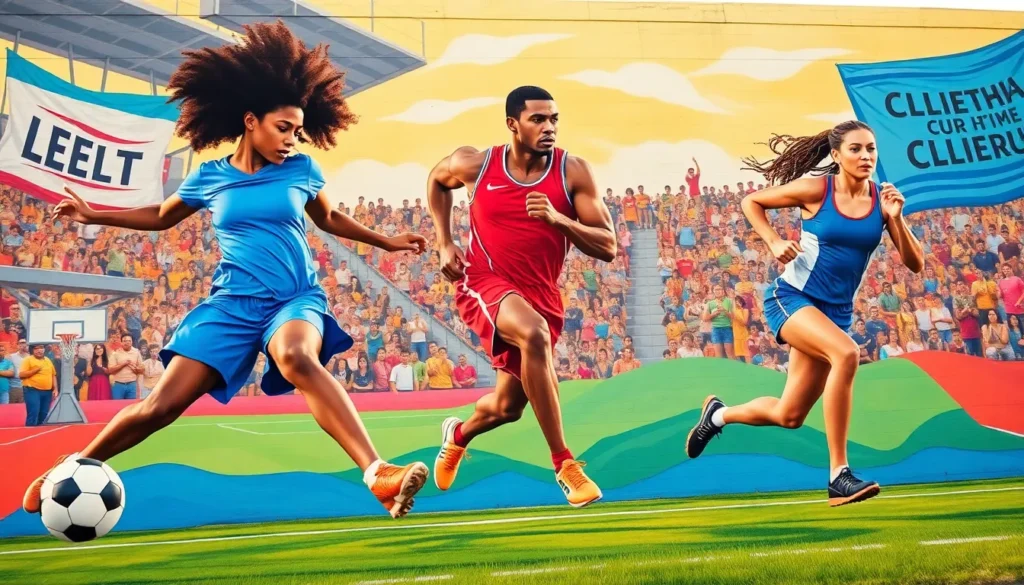In today’s dynamic landscape, sports have evolved far beyond the playing field. They interlace seamlessly with culture, technology, and social issues, creating a rich tapestry that defines modern society. This article delves into the exciting intersection of sports and culture, exploring how these realms influence each other, the pivotal role of technology, the representation of social issues within sports, and the overarching influence of media on public perception. As we venture into this exploration, we will also take a glimpse into the future of sports, highlighting emerging trends that promise to reshape the industry.
Table of Contents
ToggleUnderstanding The Intersection Of Sports And Culture

Sports are not just games: they are cultural phenomena that resonate deeply within society. From the fervent crowds at stadiums to the rituals of game day, sports reflect societal values, beliefs, and identities. For many, sports serve as a form of cultural expression, where local traditions and community pride merge.
For instance, the World Cup transcends mere competition: it showcases national identities on a global stage. Also, sporting events like the Olympics symbolize unity and showcase the diversity of cultures. The celebration of athletes’ heritages supports inclusivity and raises awareness about cultural values. In this sense, sports are a mirror to society, capturing moments of joy, strife, and change.
Besides, intersections between sports and social movements have become increasingly visible. For example, athletes use their platforms to address issues like racism and gender equality. By standing up for various causes, they amplify messages of social justice, recognizing that their influence extends beyond the game. The cultural narratives surrounding sports shape public discourse and grassroots movements, driving societal change.
The Role Of Technology In Modern Sports
Technology has revolutionized how sports are played, consumed, and analyzed. From performance-enhancing gadgets to advanced analytics, technology serves as a pivotal force in modern sports.
Wearable technology, such as fitness trackers and smart clothing, allows athletes to monitor their performance and tailor their training regimens. These innovations improve athletic performance and help prevent injuries by providing real-time feedback. Also, coaches now rely on data analytics, video analysis, and simulations to develop game strategies and enhance player development.
On the spectator side, technology has transformed how fans engage with their favorite sports. Streaming services provide on-demand access to games, while social media platforms create direct communication channels between athletes and fans. Enhanced viewing experiences via augmented reality (AR) and virtual reality (VR) allow fans to immerse themselves in the action like never before.
As technology continues to advance, its influence on sports will only grow, presenting new opportunities and challenges for athletes, coaches, and fans alike.
Social Issues Reflected In Sports
Sports often serve as a platform for addressing pressing social issues, reflecting broader societal challenges. Issues such as inequality, discrimination, and mental health have found a voice through athletic communities, showcasing the power of sports to drive conversations and inspire change.
The ongoing discussions surrounding racial inequality have prominently intersected with sports. For example, the Black Lives Matter movement has gained significant traction among athletes who voice their advocacy for racial justice and equality. High-profile athletes like LeBron James and Colin Kaepernick have used their platforms to champion social justice, bringing awareness to systemic racism.
Also, gender inequality persists in sports, with female athletes fighting for equal pay, recognition, and opportunities. The U.S. women’s national soccer team’s fight for equal pay exemplifies the ongoing struggle for gender equity in sports. This pivotal case illuminates how sports can shine a spotlight on gender disparities and influence change within the broader cultural narrative.
Mental health is another critical issue gaining attention in the sports world. Athletes are increasingly opening up about their mental health struggles, encouraging others to seek help and shed the stigma associated with mental health issues. This dialogue helps create a supportive environment and reinforces the importance of mental well-being, underscoring sports’ potential to impact societal attitudes.
The Influence Of Media On Sports Perception
The media plays a crucial role in shaping public perceptions of sports and athletes. Stories told through various platforms, including television, newspapers, and online channels, significantly influence narratives surrounding athletes and events.
Through their framing of stories, media outlets can elevate certain narratives while downplaying others. For example, how an athlete’s achievements are reported can affect public appreciation and understanding of their contributions. Sensationalized coverage can put undue pressure on athletes, while underreporting can lead to a lack of recognition.
Also, social media has transformed the media landscape, empowering fans and athletes to share their perspectives directly. This shift allows for more diverse narratives, but it also brings challenges. Misinformation can spread quickly, and athletes are often subjected to intense scrutiny online. The power dynamics of traditional media versus social media create a complex interplay that continues to evolve, influencing how sports are consumed and perceived across various audiences.
The Future Of Sports: Trends And Predictions
As the sports landscape continues to evolve, several emerging trends are set to shape its future. One significant trend is the increasing focus on sustainability. With environmental concerns at an all-time high, sports organizations are prioritizing eco-friendly practices, from reducing carbon footprints to promoting sustainability initiatives at events.
Also, the integration of e-sports into the mainstream sports narrative is an exciting development. E-sports have grown exponentially, attracting millions of fans and raising questions about the definition of sport itself. As traditional sports organizations grapple with this new reality, collaborative opportunities may arise, blending elements of both physical and digital competition.
Another noteworthy trend is the rising importance of inclusivity and diversity within sports. As athletes advocate for marginalized communities, organizations are becoming more aware of the need for diverse representation within their ranks. This shift towards inclusivity enhances the cultural fabric of sports, making it more reflective of the society it aims to represent.
Finally, technological advancements will continue to play a crucial role, with artificial intelligence (AI) and machine learning finding applications in various areas, from player recruitment to fan engagement. As these innovations emerge, they will redefine how sports are played, experienced, and understood.
Conclusion
The intersection of sports, culture, and technology reveals a dynamic relationship that impacts society as a whole. As sports continue to reflect and influence social issues, they serve as a powerful platform for change and advocacy. The role of media in shaping perceptions adds another layer of complexity to this evolving landscape. Looking ahead, the trends of sustainability, inclusivity, and technological innovation promise exciting opportunities for the future of sports. By embracing these changes, stakeholders in the sports industry can drive meaningful progress and ensure that sports remain a vibrant and influential aspect of our culture.






